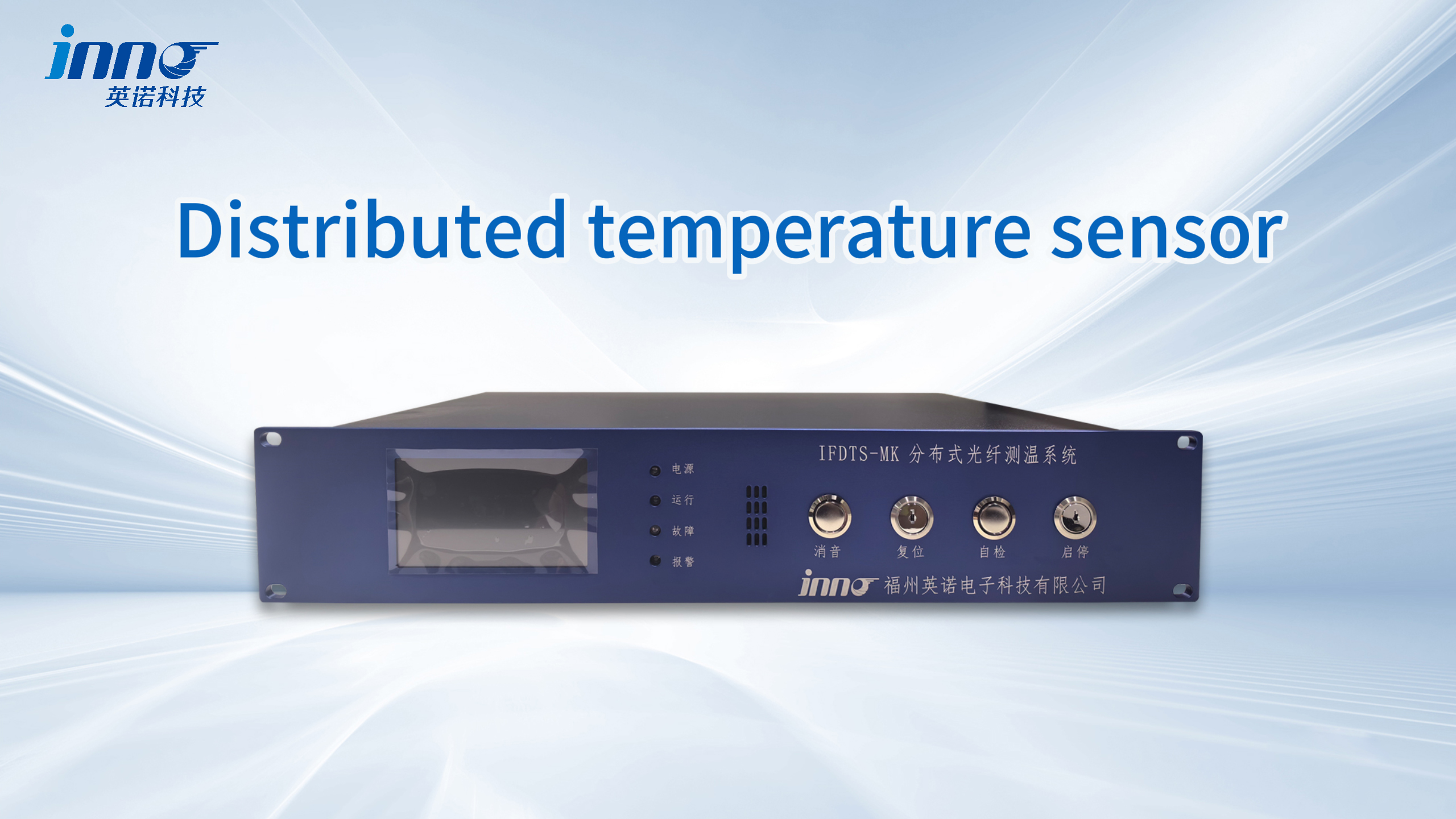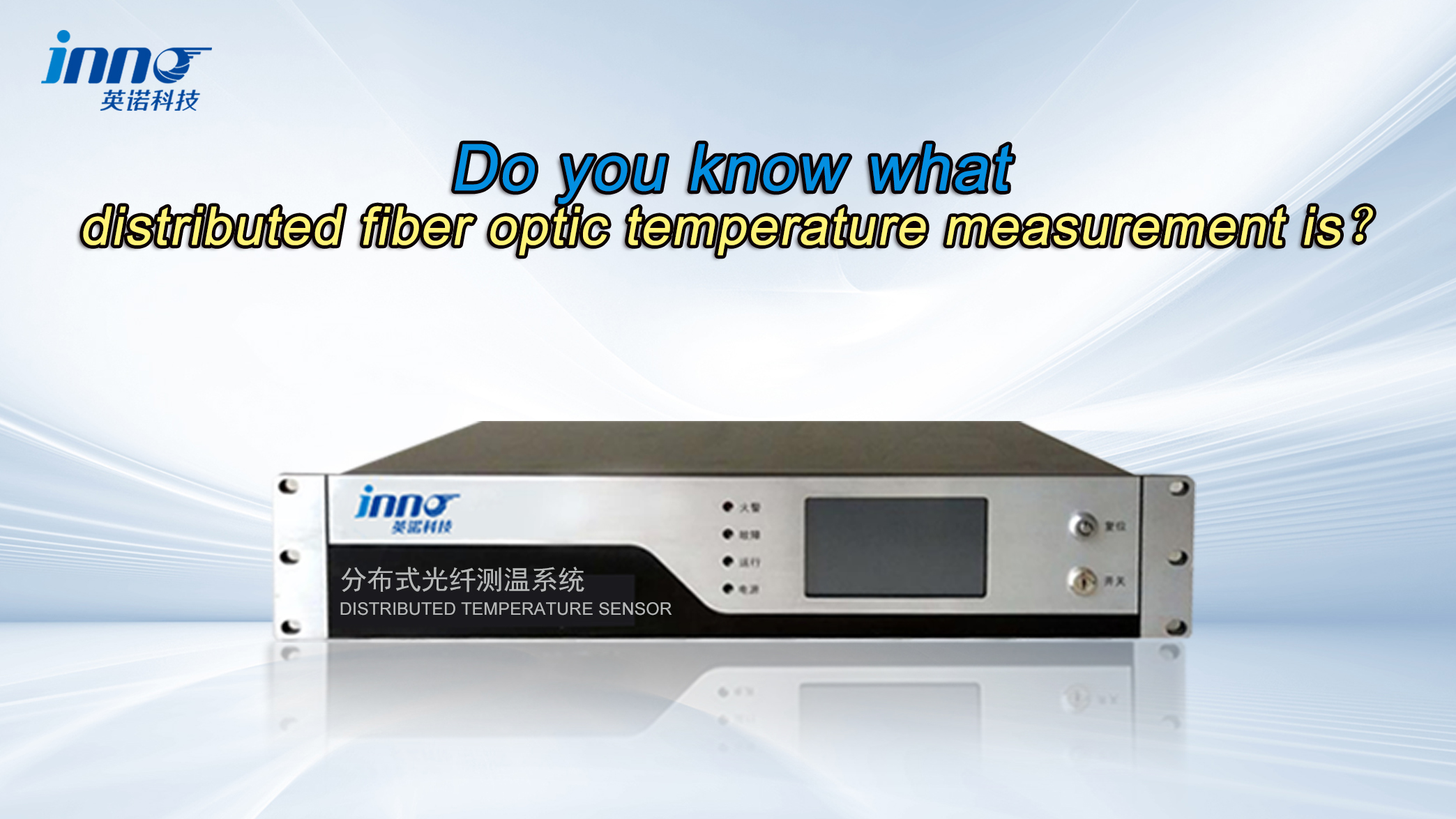Teplotní senzor s optickými vlákny, Inteligentní monitorovací systém, Výrobce distribuovaných optických vláken v Číně
 |
 |
 |
Principle of distributed optical fiber monitoring for long-distance cable conduits
Distributed fiber optic sensing (DFOS) technology is a new type of sensing technology that has the advantages of long sensing distance, passivity, strong anti-interference ability, good durability and matching, and easy networking. It has become the preferred technology for implementing distributed monitoring.
The principle is to simultaneously use optical fibers as sensing sensitive elements and transmission signal media, and adopt advanced Optical Time Domain Reflectometer (OTDR) technology to detect changes in strain and temperature at different positions along the optical fiber, achieving truly distributed measurement. In terms of sensing technology, there are mainly three implementation methods: based on Rayleigh scattering, based on Raman scattering, and based on Brillouin scattering. The distributed fiber optic sensing technology based on Brillouin scattering has achieved higher measurement accuracy, measurement range, and spatial resolution in temperature and strain than other sensing technologies, and has received widespread attention and research. Brillouin scattering is a light scattering process that occurs when light waves and sound waves propagate in optical fibers, resulting in inelastic collisions. Fiber optic sensing technology utilizes the unique characteristics of optical fibers to detect temperature, tlak, and acoustic vibration (sound) changes along the fiber optic line, transforming the fiber optic into a long-distance distributed fiber optic sensor. By burying fiber optic cables near pipelines or connecting them to pipelines, operators can continuously monitor the structural health and operational status of these critical assets.

Method for Distributed Fiber Optic Monitoring of Temperature in Long Distance Cable Pipelines
The distributed fiber optic temperature monitoring system is developed based on the principles of Raman scattering and optical time domain reflectometry (OTDR) positioning. It has functions such as optical signal generation, photoelectric conversion, signal amplification, and processing, and has good performance indicators and system stability. The system adopts a dedicated temperature sensing optical cable as the temperature sensor, integrating computer, fiber optic communication, fiber optic sensing, photoelectric control and other technologies. It has the advantages of intrinsic safety, corrosion resistance, and immunity to electromagnetic interference. It can continuously monitor long-distance and large-scale environmental temperature information, providing high-quality temperature monitoring solutions for fields such as electricity, petroleum, coal mining, heat, and transportation. The detection cable uses ordinary standard multimode optical fibers to connect DTS for distributed temperature measurement, which can be customized according to user needs. Common detection cable structures include 0.6mm multimode optical fiber, stainless steel metal hose, Kevlar, stainless steel braided layer, and PVC sheath. Distributed Temperature Sensor (DTS) technology is achieved by combining the principles of laser Raman backscattering and optical time domain reflection. This technology can meet the needs of long-distance, distributed, and real-time monitoring.
Distributed fiber optic security monitoring technology for long-distance cable conduits
Distributed fiber optic sensing technology has important applications in the security monitoring of long-distance cable pipelines. Taking the pipeline fiber optic warning solution as an example, it is based on the advantages of fiber optic intrinsic safety, easy deployment, and all-weather coverage. It can collect and monitor vibrations within the monitoring bureau for analysis and positioning, and is a new tool for pipeline inspection. This solution can achieve high-precision automatic inspection and warning 24/7 through light sensing devices and sensing algorithm engines. When external construction occurs around the pipeline, the accompanying optical fiber deployed along the pipeline collects vibration information and transmits it to the optical sensing equipment deployed in the plant station or valve room. The accuracy of event recognition can reach 97%. The pipeline fiber optic warning solution incorporates an innovative enhanced module with a super strong blind spot correction algorithm, which can correct and shape the phase of the collected weak signals, greatly improving the effectiveness of weak signals. Compared with the industry average, it can increase the effective signal acquisition rate to 99.9%. The vibration ripple recognition engine can analyze and restore construction events from multiple dimensions. For each construction vibration occurrence point, phase information can be obtained and multi-dimensional features (such as voiceprint, frekvence, space, time sequence, duration, atd.) can be extracted. Multidimensional deep convolution recognition compares samples, improving the accuracy of event recognition to 97%, exceeding the industry average level. And in cooperation with relevant geological research universities in China, importing a large amount of geological data can achieve daily iteration of new event samples, continuous evolution, and continuously improve the accuracy of perception and warning. Meanwhile, fiber optic sensing equipment can iterate based on new construction behavior data and different geological environment scenarios in the database.

Key points for distributed fiber optic vibration monitoring of long-distance cable conduits
Distributed fiber optic vibration monitoring technology is based on the basic principle of Rayleigh scattering, combined with φ – OTDR (phase sensitive time domain reflectometry) technology and signal analysis and processing algorithms, to achieve fiber optic vibration sensing monitoring. Distributed fiber optic vibration sensors, as important components in fiber optic sensor related technologies, have the advantages of non radiative interference, good resistance to electromagnetic interference, and good chemical stability that ordinary fiber optic sensors have. They also have the characteristic of one-dimensional spatial continuous distribution that fiber optic sensors possess. In practical applications, such as the research on intelligent fiber optic warning systems for long-distance pipeline safety, intrusion signals around the pipeline are collected from a distributed fiber optic sensing system called OTDR (phase sensitive optical time domain reflectometry), Long short term memory, fully connected deep neural networks are used to establish a recognition model and achieve the recognition of passing signals. After training and blind testing, the recognition model for passing events constructed has good recognition and positioning effects in actual long-distance fiber optic monitoring environments, effectively reducing the false alarm rate of the warning system.
Distributed fiber optic leakage alarm mechanism for long-distance cable conduits
There are various methods and mechanisms for distributed fiber optic monitoring in the leakage monitoring of long-distance cable conduits. The DAS pipeline leak monitoring system can synchronously monitor the operation of hundreds of kilometers of long-distance pipelines based on four indicators in real time. Thanks to its advanced software and event data recognition algorithm, it can ensure the accuracy of leak event monitoring while also covering the identification of potential threats such as ground and construction vibrations. It adopts distributed fiber optic acoustic sensing (DAS) technology and is based on a phase sensitive optical time domain reflectometer (Φ – OTDR) to detect the backward Rayleigh scattering signal generated by coherent pulsed light propagating in the fiber, and based on this, detect and reconstruct leakage events. It mainly consists of optical fiber, optical signal amplifier/demodulator, high coherence pulse laser source, and data processing analyzer. It has a unique 4-mode leak event monitoring mode:
NPP (Negative Pressure Pulse): This feature is generated immediately during the main disturbance event and propagates rapidly in both directions within the measured object; The signal is coupled with the measured object and received by a continuous external optical fiber. This is usually the most sensitive detection mode and a rather unique signal.
OFN (Event Noise): When a pipeline leakage event occurs, the flow of the leaked material at the leakage port will generate corresponding and detectable noise signals. Noise signals are generally high-frequency sound signals and will be generated at the moment of pipeline leakage. Small disturbance events only produce very small acoustic components, so fiber optic cables need to be placed as close as possible to the measured pipeline.
Environmental strain (deformation of the measured object): In underground pipeline leakage events, gas or liquid leakage will cause compression, permeation, and filling of the surrounding medium, which will lead to deformation of the medium near the pipeline leakage port. The DAS system can accurately locate the leakage location by monitoring the environmental strain. For large disturbances or deformation events, an alarm will be immediately triggered. For small disturbances or deformations, no alarm will be issued before the event effect reaches the fiber optic cable. The length of this period depends on the offset and direction of the fiber optic cable.
DTGS (Distributed Temperature Gradient Sensing): Pipeline contents generally have a certain temperature difference from the external environment. When leaked materials (gases or liquids) escape into the external environment of the pipeline, due to the high sensitivity of backward Rayleigh scattering light in the optical fiber, even small temperature changes can have a demodulated effect on its phase. The alarm requires a disturbance event (or temperature effect) to reach the fiber optic cable, and usually only appears after a delay of some time. This period depends on the offset of the cable, the condition and direction of the measured object. Navíc, there is a method for pipeline leakage monitoring using a distributed fiber optic vibration sensing (DVS) system based on multidimensional spatial data fusion algorithm. The sensing optical cable is fixed on the side of the pipeline, and the pipeline leakage signal is picked up by the DVS system. The pipeline leakage signal is averaged in the spatiotemporal domain according to the time window and spatial resolution, and an appropriate threshold is set to complete pipeline leakage monitoring and alarm. In the experiment, single point leakage and multi-point leakage were tested, and the signal-to-noise ratio of single point pipeline leakage signal increased by 4.5 dB. The highest single point pipeline leakage alarm rate increased by 19.53%, and the highest multi-point pipeline leakage alarm rate increased by 2.29%. Real time monitoring and alarm of 0.2 MPa pipeline leakage were achieved.
 Teplotní senzory s optickými vlákny INNO ,Systémy monitorování teploty.
Teplotní senzory s optickými vlákny INNO ,Systémy monitorování teploty.
